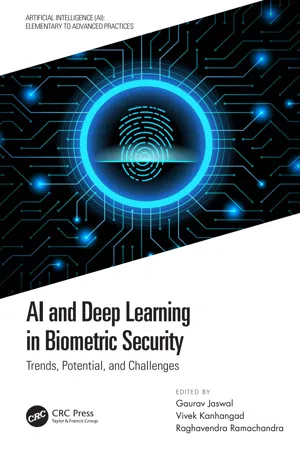
AI and Deep Learning in Biometric Security
Trends, Potential, and Challenges
- 364 pages
- English
- ePUB (mobile friendly)
- Available on iOS & Android
AI and Deep Learning in Biometric Security
Trends, Potential, and Challenges
About this book
This book provides an in-depth overview of artificial intelligence and deep learning approaches with case studies to solve problems associated with biometric security such as authentication, indexing, template protection, spoofing attack detection, ROI detection, gender classification etc.
This text highlights a showcase of cutting-edge research on the use of convolution neural networks, autoencoders, recurrent convolutional neural networks in face, hand, iris, gait, fingerprint, vein, and medical biometric traits. It also provides a step-by-step guide to understanding deep learning concepts for biometrics authentication approaches and presents an analysis of biometric images under various environmental conditions.
This book is sure to catch the attention of scholars, researchers, practitioners, and technology aspirants who are willing to research in the field of AI and biometric security.
Frequently asked questions
- Essential is ideal for learners and professionals who enjoy exploring a wide range of subjects. Access the Essential Library with 800,000+ trusted titles and best-sellers across business, personal growth, and the humanities. Includes unlimited reading time and Standard Read Aloud voice.
- Complete: Perfect for advanced learners and researchers needing full, unrestricted access. Unlock 1.4M+ books across hundreds of subjects, including academic and specialized titles. The Complete Plan also includes advanced features like Premium Read Aloud and Research Assistant.
Please note we cannot support devices running on iOS 13 and Android 7 or earlier. Learn more about using the app.
Information
1
Contents
1.1 Introduction
Table of contents
- Cover
- Half Title
- Series Page
- Title Page
- Copyright Page
- Table of Contents
- Preface
- Editors
- Contributors
- Chapter 1 Deep Learning-Based Hyperspectral Multimodal Biometric Authentication System Using Palmprint and Dorsal Hand Vein
- Chapter 2 Cancelable Biometrics for Template Protection: Future Directives with Deep Learning
- Chapter 3 On Training Generative Adversarial Network for Enhancement of Latent Fingerprints
- Chapter 4 DeepFake Face Video Detection Using Hybrid Deep Residual Networks and LSTM Architecture
- Chapter 5 Multi-spectral Short-Wave Infrared Sensors and Convolutional Neural Networks for Biometric Presentation Attack Detection
- Chapter 6 AI-Based Approach for Person Identification Using ECG Biometric
- Chapter 7 Cancelable Biometric Systems from Research to Reality: The Road Less Travelled
- Chapter 8 Gender Classification under Eyeglass Occluded Ocular Region: An Extensive Study Using Multi-spectral Imaging
- Chapter 9 Investigation of the Fingernail Plate for Biometric Authentication using Deep Neural Networks
- Chapter 10 Fraud Attack Detection in Remote Verification Systems for Non-enrolled Users
- Chapter 11 Indexing on Biometric Databases
- Chapter 12 Iris Segmentation in the Wild Using Encoder-Decoder-Based Deep Learning Techniques
- Chapter 13 PPG-Based Biometric Recognition: Opportunities with Machine and Deep Learning
- Chapter 14 Current Trends of Machine Learning Techniques in Biometrics and its Applications
- Index